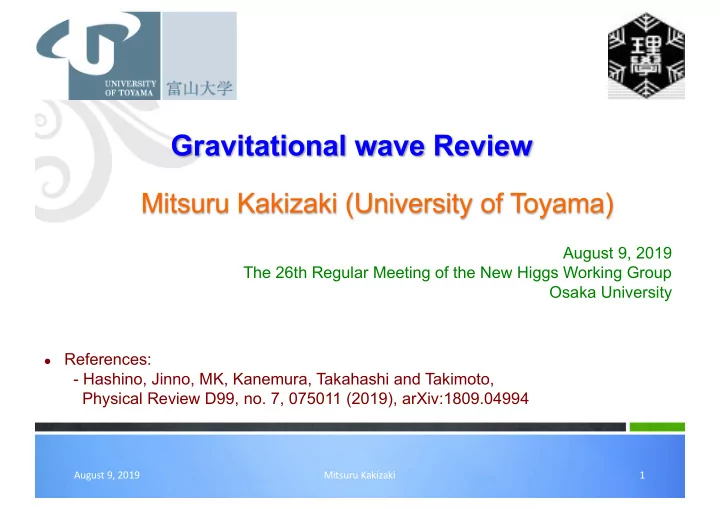

Gravitational wave Review Mitsuru Kakizaki (University of Toyama) August 9, 2019 The 26th Regular Meeting of the New Higgs Working Group Osaka University References: l - Hashino, Jinno, MK, Kanemura, Takahashi and Takimoto, Physical Review D99, no. 7, 075011 (2019), arXiv:1809.04994 August 9, 2019 Mitsuru Kakizaki 1
Contents 1. Introduction 2. Gravitational waves 3. Gravitational waves from first order phase transition 4. Expected constraints on model parameters 5. Summary August 9, 2019 Mitsuru Kakizaki 2
Motivation Discovery of the 125 GeV Higgs boson at the CERN LHC h l The Standard Model (SM) has been established as a low-energy effective theory below GeV O (100) This is not the end of the story Puzzles in the Higgs sector Guiding principle? l Shape of the Higgs potential (multiplets, symmetries, ...)? l Dynamics behind the electroweak symmetry breaking (EWSB)? l Phenomena beyond the SM (BSM) Baryon asymmetry of the Universe (BAU) l Cosmic inflation l Existence of dark matter l Neutrino oscillations l Idea: Higgs sector = Window to New Physics l The structure of the Higgs sector is related to BSM models Information on new physics can be obtained by investigating the properties of the Higgs sector August 9, 2019 Mitsuru Kakizaki 3
Electroweak baryogenesis (EWBG) and Higgs boson couplings Sakharov’s conditions for BAU 1 st OPT 1. Baryon number violation Sphaleron process 2. Violation of C and CP Tunneling Extended Higgs sector 3. Departure from thermal equilibrium ϕ c ϕ Strongly first order phase transition (1 st OPT): Potential SM Higgs sector w/ one doublet: barrier True vacuum l Electroweak phase transition (EWPT) is NOT of 1 st order for m h = 125 GeV EWBG is an important physics case relating the Higgs sector to BSM phenomena August 9, 2019 Mitsuru Kakizaki 4
Strongly 1 st OPT and Higgs boson couplings Models with extended Higgs sector l 1 st OPT can be easily realized l Signatures are testable at colliders e.g. Two Higgs doublet model (2HDM) l Condition for strongly 1 st OPT: ϕ c /T c & 1 Large deviation in the triple Higgs boson coupling ( ∆ λ hhh / λ SM hhh & 10%) EWPT can be tested at future colliders [Kanemura, Okada, Senaha (2005)] l High-Luminosity LHC: − 1 . 3 . ∆ λ hhh / λ SM hhh . 8 . 7 [ATL-PHYS-PUB-2014-019] l International Linear Collider (ILC) ( ) √ s = 1 TeV L = 5 ab − 1 [Fujii et al. (2015)] ∆ λ hhh : 10% CP phases can generate observable electric dipole moments August 9, 2019 Mitsuru Kakizaki 5
Gravitational waves (GWs) as a probe of EWPT Ground-based interferometers: Advanced LIGO, Advanced Virgo, KAGRA, ... l Main targets: GWs from binary systems, supernovae, ... New era of GW astronomy - GW150914 from a binary black hole: [LIGO and Virgo (2016)] First direct observation of GWs - GW170817 from a neutron star merger: Breakthrough for multi-messenger astronomy Future space-based interferometers: LISA (2034-), DECIGO, ... l Sensitive to GWs from the early Universe (Strongly 1 st OPT, cosmic inflation, ...) New era for fundamental physics August 9, 2019 Mitsuru Kakizaki 6
Synopsis Unraveling the Unveiling the mystery of the underlying theory baryon asymmetry beyond the SM Identification of the Higgs sector Synergy Measurement of Observation of Measurement of various Higgs boson GW spectrum the triple Higgs couplings κ X boson coupling (HL-)LHC, ILC, CLIC, LISA, DECIGO, etc. FCC-ee, CEPC, etc. ILC, CLIC, etc. August 9, 2019 Mitsuru Kakizaki 7
Our Universe (in mathematical language) = Standard Model x General Relativity + New Physics l The goal of this research is to reveal unknown terms for new physics (dark matter, baryon asymmetry, etc.) August 9, 2019 Mitsuru Kakizaki 8
KAGRA l Underground and cryogenic interferometer with 3km arms located in Kamioka Now: l Finished construction and all the installations l Under commissioning Preparing a sapphire mirror (U. Toyama) Plan: l To join LIGO-Virgo observing run 3 (O3) from the end of 2019 [Talk by H. Shinkai at GR22/Amaldi13] August 9, 2019 Mitsuru Kakizaki 9
Contents 1. Introduction 2. Gravitational waves 3. Gravitational waves from first order phase transition 4. Expected constraints on model parameters 5. Summary August 9, 2019 Mitsuru Kakizaki 10
Gravitational Waves Gravitational waves (GWs) l Non-uniform motion of a massive object Ripples of spacetime propagating at the speed of light c.f. Non-uniform motion of a charged object Electromagnetic waves Properties of gravitational waves l Transverse to the direction of propagation l Spin 2 l 2 polarization modes: Plus mode h+ & Cross mode hx Sources of gravitational waves Cosmic origin Astrophysical origin l 1st order phase transition l Binaries (NS, BH, ...) l Cosmic inflation l Supernovae l Topological defects l etc. August 9, 2019 Mitsuru Kakizaki 11
Recommend
More recommend